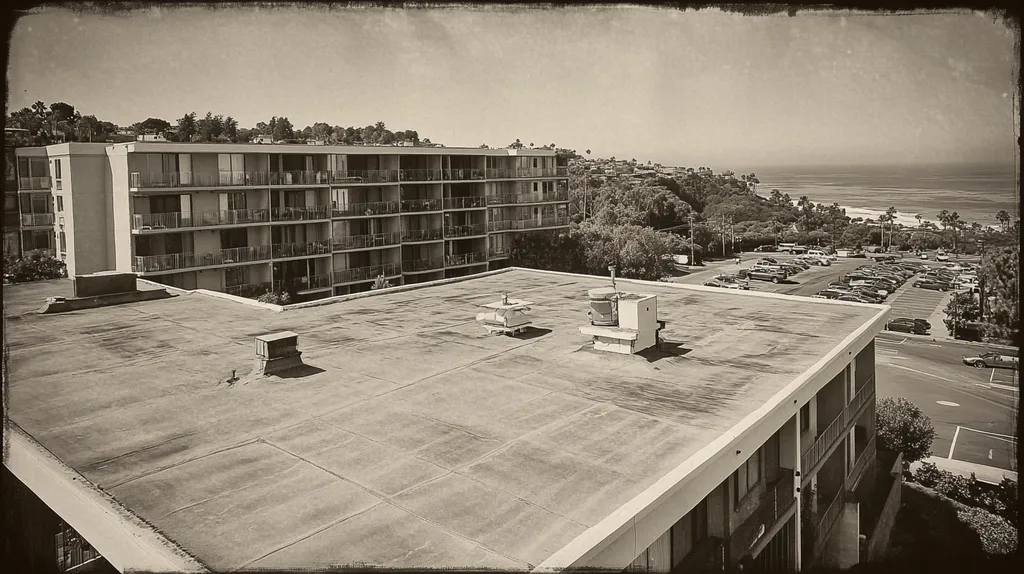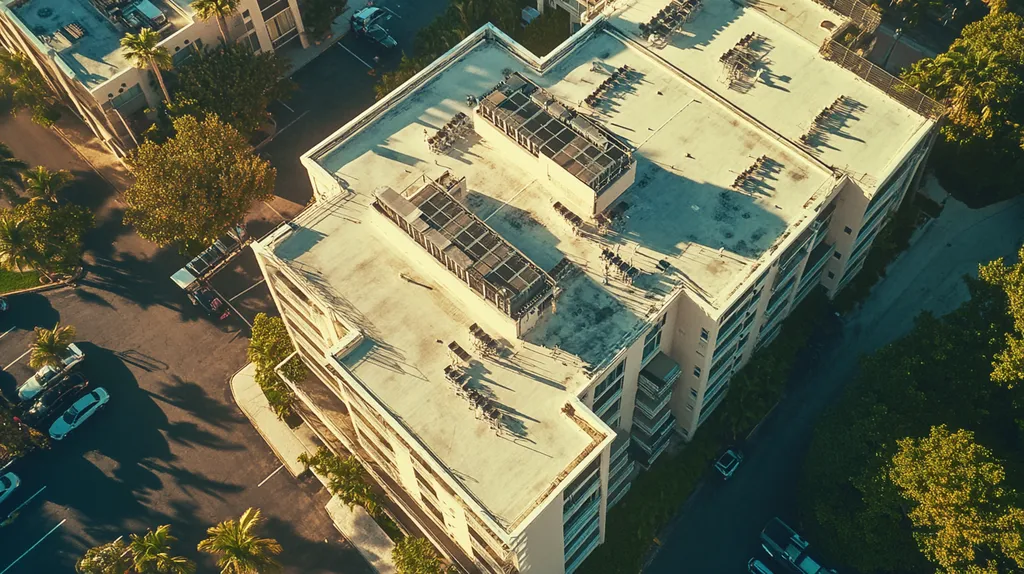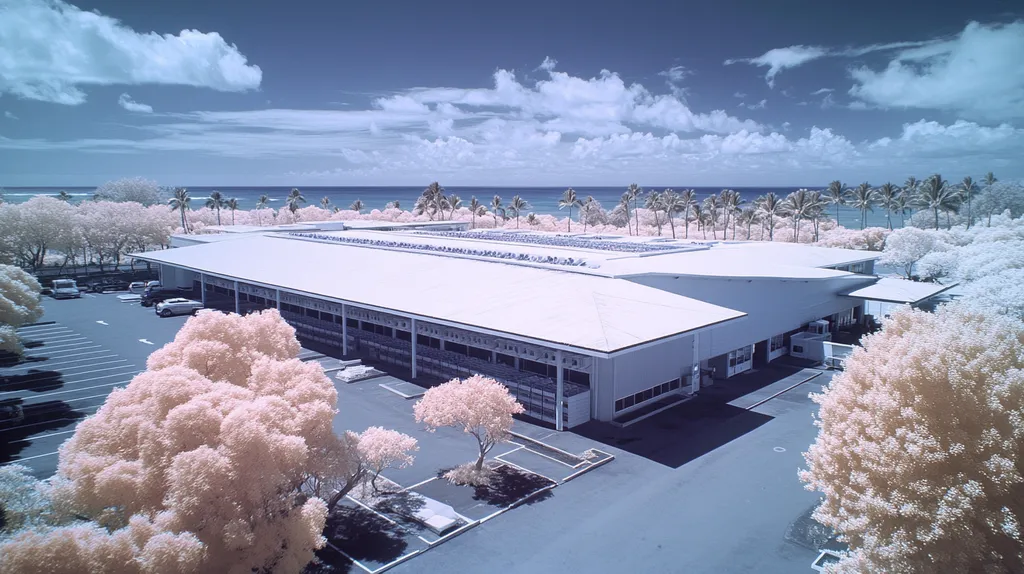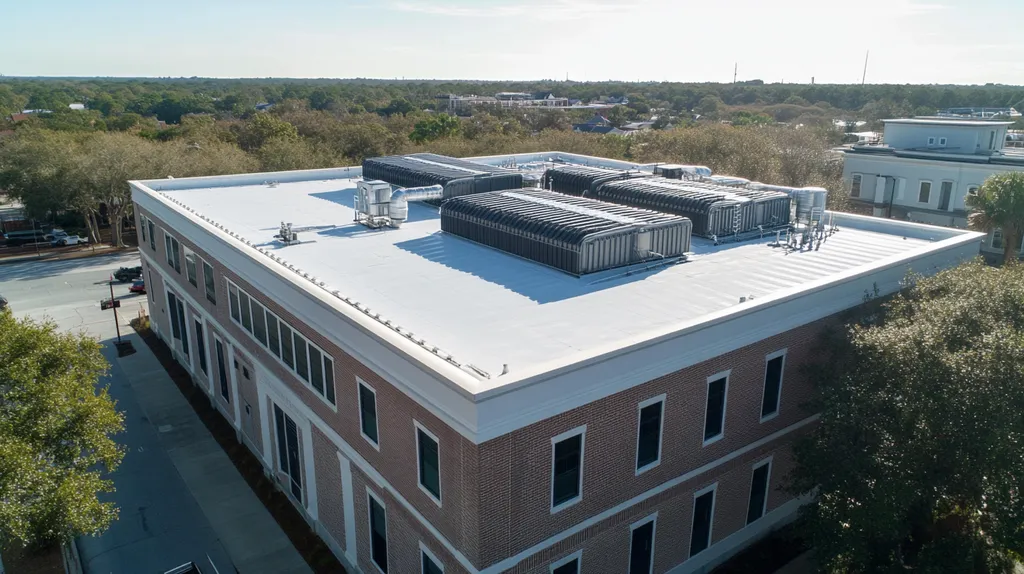Each year, seasonal changes inflict over $1.5 billion in damage to commercial roofs across North America, with temperature fluctuations and moisture being the primary culprits. For facility managers, understanding these impacts has never been more critical.
From structural integrity concerns to compliance requirements, the challenges of maintaining commercial roofs through seasonal transitions have evolved dramatically since the days of simple tar and gravel systems.
This comprehensive guide examines proven strategies for protecting roofing investments across seasons, exploring critical areas including performance factors, financial considerations, and risk management protocols essential for modern facility operations.
SECTION 1: PERFORMANCE FACTORS
Seasonal changes can take a significant toll on commercial roofs, profoundly influencing their longevity and overall effectiveness. Failing to address these shifts can result in detrimental consequences, including costly repairs and safety hazards. For instance, a heavy snowfall can add approximately 20 pounds per square foot to a roof’s load, potentially exceeding its limits. Facility managers must understand these seasonal impacts to effectively mitigate risks and maximize the lifespan of their roofs.
Seasonal Impact on Roof Materials
Roofing materials respond differently to seasonal fluctuations, which can directly impact their performance. For example, asphalt shingles may harden and become brittle in severe cold, while EPDM membranes can shrink, leading to cracks and leaks. These vulnerabilities can significantly compromise the roof’s integrity if left unaddressed.
To maintain effective roofing systems, facility managers must grasp how materials react to temperature variations. A roof exhibiting cracks during the summer months may face disastrous failures in winter. Therefore, assessments should be conducted at each seasonal transition to catch early signs of distress.
Utilizing reflective coatings is one proactive strategy to combat summer heat, which not only safeguards roofing materials but also reduces energy costs. Consulting specific material guidelines can further enhance both longevity and performance.
Key Action Items
Structural Integrity and Load Capacity
Seasonal shifts bring about changes in load capacities associated with snow, ice, and rain. Winter weather can unleash heavy snowfall that surpasses the design load limits of many commercial roofs, potentially leading to structural failures. Facility managers must proactively assess their roof’s load capacity as winter creeps in.
For instance, a roof initially designed to support 30 pounds per square foot may end up overburdened during unexpected heavy snow. Conducting regular structural assessments is essential to prevent catastrophic failures that could endanger safety.
In addition, summer storms can lead to roof ponding, further adding weight and exposing existing weaknesses. Understanding load capacities is vital for establishing effective drainage strategies that can accommodate seasonal water flows without compromising structural integrity.
Key Action Items
Drainage and Water Management
Efficient drainage systems are crucial to effective seasonal roof maintenance. Proper water management prevents ponding, which can lead to leaks and significant structural damage. Weak drainage setups can cause water accumulation, posing risks especially during heavy rainfall or snowmelt.
Facility managers must conduct regular inspections of gutters and downspouts, particularly during seasonal transitions. Clogged or damaged drainage systems can worsen existing problems, leading to costly repairs and extended downtime.
Furthermore, seasonal changes impact water characteristics on rooftops. Melting snow can rapidly increase water volume, making efficient drainage solutions indispensable. Crafting a robust water management strategy is key to preventing potential flooding and the consequent structural damage.
Key Action Items
SECTION 2: FINANCIAL CONSIDERATIONS
Seasonal changes can dramatically affect a commercial property’s financial stability. Ignoring essential roof maintenance can lead to expensive repairs or even early replacements. Alarmingly, studies show that around 70% of roofing failures stem from improper maintenance. Thus, understanding the financial repercussions of seasonal changes is vital for facility managers and property owners alike.
Cost of Seasonal Maintenance
Investing in seasonal upkeep may appear overwhelming, but these costs are often minimal compared to emergency repairs. Regular inspections and preventive fixes can avert serious damage from harsh weather. For example, clearing debris from gutters and drains can prevent water pooling, which could lead to significant leaks and structural harm.
Moreover, neglecting seasonal impacts can dramatically inflate repair expenses. A tiny crack could escalate into extensive water damage, necessitating costly interior repairs. Additionally, unattended leaks can impact insulation and energy efficiency, resulting in higher utility bills.
Facility managers should weigh the expense of regular maintenance against potential repair costs. Creating a maintenance schedule ensures safety and safeguards the property’s long-term integrity, serving as a proactive fiscal strategy to avoid financial strain down the line. Ultimately, expenditures on routine upkeep should be seen as investments in the longevity of the roofing system.
Key Action Items
Budgeting for Repairs and Replacements
Strategic budgeting for roof repairs and replacements requires foresight and careful planning. Facility managers must evaluate the roof’s age, current condition, and local environmental factors to allocate appropriate funds. For instance, a roof nearing the end of its lifespan may necessitate a larger budget for timely replacements or upgrades.
As seasons shift, budgeting should be adaptive. Managers should not only incorporate funds for prompt repairs but also reserve resources for unforeseen expenses. Establishing a reserve fund allows for quick responses to unexpected damage, safeguarding both property and budget.
Comparative analyses can inform budgeting choices. For instance, facilities in snow-heavy regions may need to earmark extra funds for snow removal and ice prevention methods. Proactively allocating resources for these specific challenges can lead to substantial savings over time.
Key Action Items
ROI on Preventive Maintenance
The return on investment (ROI) for preventive maintenance is considerable. Research indicates that spending on preventive measures can yield savings of 10-20 times the initial investment compared to reactive repairs. For instance, a facility manager investing in regular inspections may uncover minor issues, costing just hundreds to fix instead of thousands later on.
Additionally, preventive maintenance promotes energy efficiency. A well-maintained roof enhances insulation, reducing thermal loss and lowering energy expenditures. This leads to ongoing savings that extend well beyond initial maintenance investments.
Another critical factor is the impact on property value. Buildings with a documented maintenance history tend to retain higher resale values. Potential buyers often view a solid upkeep record as a sign of responsible management, enhancing marketability.
Key Action Items
SECTION 3: COMPLIANCE REQUIREMENTS
Recognizing and adhering to compliance requirements is essential for facility managers as they navigate the seasonal challenges presented by commercial roofs. Local building codes and regulations dictate necessary maintenance practices to ensure safety and performance. Ignoring these regulations can lead to significant penalties or structural dangers, making it crucial to remain compliant. Furthermore, following warranty and service contract stipulations safeguards roofing investments. Finally, aligning with industry standards not only prevents costly repairs but also extends the lifespan of the roofing system.
Local Building Codes and Regulations
Local building codes establish safety and performance guidelines that facility managers must follow during roofing work. These regulations are designed to protect structural integrity and promote energy efficiency, ensuring that roofing materials withstand local conditions, such as high winds or heavy snow loads. Non-compliance can result in financial penalties and expose occupants to safety risks.
Building codes are continually evolving with advancements in roofing technology and materials. Staying updated is vital for maintaining compliance, and regular communication with local building authorities can provide insights on current and upcoming requirements that impact roofing decisions.
To minimize risks, facility managers should create a checklist based on applicable codes before starting any roofing project. This proactive approach helps ensure that all work is compliant with legal standards and can be advantageous during future inspections or disputes.
Key Action Items
Warranty and Service Contract Compliance
Warranties and service contracts serve as protective measures for roofing investments, often including maintenance protocols that must be adhered to for validity. Regular inspections, sometimes mandated annually, are essential to identify and resolve issues before they escalate into costly repairs.
Failure to comply with warranty stipulations can void coverage, placing the financial burden of repairs on property owners. Facility managers should thoroughly review all warranty terms and set up reminders for maintenance checks to ensure compliance and protect investments.
Establishing a service contract with a roofing professional can alleviate compliance challenges. These contracts typically include scheduled inspections and detailed documentation, providing peace of mind. Maintaining accurate records of inspections and service actions is also critical for pursuing warranty claims if necessary.
Key Action Items
Industry Standards for Roof Maintenance
Industry standards play a critical role in defining best practices for roof maintenance. Organizations like the National Roofing Contractors Association (NRCA) provide guidelines on maintenance schedules and practices that are effective in enhancing roof longevity while ensuring safety.
For example, biannual inspections, particularly after severe weather, are often recommended to catch potential issues early. Adhering to these standards can help mitigate the risk of costly repairs and unexpected outages during peak seasons.
Additionally, participating in industry training programs keeps facility managers informed about best practices and emerging technologies, which can lead to improved maintenance approaches. Incorporating these industry standards into planning and budgeting processes promotes proactive and informed decision-making concerning roofing systems.
Key Action Items
SECTION 4: RISK MANAGEMENT
Seasonal changes introduce a range of hazards that can threaten the structural integrity of commercial roofs, ultimately jeopardizing the safety of occupants. Winter storms, for example, can cause ice damming, leading to leaks and mold growth. To protect their investments and ensure operational continuity, facility managers must proactively identify these seasonal hazards. By understanding and anticipating these risks, they can take decisive action before small problems develop into costly repairs.
Identifying Potential Seasonal Hazards
The first step in effective risk management is identifying potential seasonal hazards. Common issues, such as snow buildup, ice dams, and heavy rainfall, present distinct threats to roofing systems. For instance, excessive snow accumulation can strain the roof structure, increasing the risk of collapse.
Clogged gutters can obstruct drainage, causing water to pool, which compromises roofing materials and can result in leaks. Regular inspections during seasonal transitions allow facility managers to identify and address these issues before they escalate.
Using monitoring technology that tracks moisture levels and temperature can also enhance hazard detection, providing valuable insights that pinpoint potential problems early. Additionally, having an emergency preparedness plan can minimize damage in unexpected weather events, ensuring safety and readiness.
Key Action Items
Mitigating Water Damage and Leaks
Water damage and leaks pose significant risks during seasonal transitions. Any intrusion of water can lead to structural damage, mold growth, and expensive repairs. Facilities can adopt a set of preventive measures to minimize the likelihood of leaks and associated damages.
Routine inspections before and after severe weather are crucial. Checking for loose flashing and damaged seams allows for timely repairs that can prevent leaks. Additionally, investing in high-quality roofing materials adds a crucial layer of protection.
Maintaining clear and functional drainage systems is key to effective water management. Regular cleaning of gutters ensures water is directed away from the roof and building. Applying waterproof coatings can also enhance resistance to water infiltration and provide additional protection.
Key Action Items
Preventing Structural Failures
Structural failures arising from seasonal changes can have severe consequences for commercial properties. Accumulation of snow and ice is one of the primary risks, particularly for older buildings or those with low-slope roofs.
Regular evaluation of snow loads is essential. Facility managers should stay familiar with local snow load regulations and closely monitor their roofs during heavy snowfall. Developing an actionable snow removal strategy can help prevent excess weight and associated risks.
Consulting roofing professionals aids in identifying and addressing structural weaknesses. Ensuring roofs are engineered to withstand seasonal stress is crucial for reducing vulnerabilities. Training staff on emergency response protocols allows for timely reporting of unusual conditions, enhancing safety and risk management.
Key Action Items
SECTION 5: OPERATIONAL PROCEDURES
As seasonal weather changes threaten the integrity of commercial roofs, proactive operational procedures become vital for safeguarding both properties and occupants. Poor management can lead to a staggering 20% increase in roof-related maintenance costs. To mitigate these risks, facility managers must prioritize regular inspections, consistent cleaning, and prompt responses to seasonal challenges. By implementing these effective practices, the lifespan of roofs can be extended, ensuring a secure environment for all.
Scheduling Biannual Inspections
Biannual inspections are instrumental in catching potential roof issues early. The optimal times for these assessments are at the end of fall and the beginning of spring. During inspections, facility managers should thoroughly examine the entire roof, focusing on key components like flashing, drainage systems, and membrane integrity.
Documenting findings and repairs is crucial for tracking the roof’s condition over time. Historical data is not only valuable for warranty compliance but can also serve as evidence in claims relating to leaks or damage.
Engaging a qualified roofing professional ensures that complex issues are detected promptly. Undetected cracks or weak spots could lead to leaks that ultimately compromise the building’s structural integrity.
Key Action Items
Routine Cleaning and Debris Removal
Maintaining a clean roof is a fundamental aspect of any successful maintenance plan. Accumulated debris such as leaves and branches can obstruct drainage systems, resulting in problematic ponding water, especially during heavy rains or snowmelt.
Establishing a regular cleaning schedule, ideally monthly during peak debris periods, is essential. Routine cleaning not only minimizes the risk of water damage but also extends the lifespan of roofing materials.
Employing appropriate tools and safety measures during cleaning is crucial. Power washers are effective for tough stains, while hand tools help remove smaller debris. A systematic cleaning approach enhances roof performance and prevents costly repairs over time.
Key Action Items
Addressing Seasonal-Specific Issues
Each season brings distinct challenges that require tailored management strategies. For example, winter weather can create ice dams, causing water backup and leaks. Recognizing early signs of ice formation is crucial to avoiding significant repair costs.
During the hot summer months, elevated temperatures can accelerate wear on roofing materials. Applying heat-reflective coatings is a proactive strategy that can help keep temperatures down and enhance lifespan.
In the fall, inspecting gutters and downspouts for leaf blockages is critical; clogs can lead to overflow and potential roof damage. Addressing such seasonal-specific issues before they escalate can prevent a series of problems throughout the winter months.
Key Action Items
SECTION 5: OPERATIONAL PROCEDURES
As the seasons change, so do the risks to commercial roofs, making proactive operational procedures essential. Failing to manage these risks can contribute to a significant rise—up to 20%—in roof-related maintenance costs. Facility managers must prioritize timely inspections, regular cleanings, and swift action against seasonal-specific challenges to preserve roof integrity and prevent costly damages for the building and its occupants.
Scheduling Biannual Inspections
Biannual inspections are vital for identifying potential issues before they escalate into major problems. The ideal times for these assessments are at the end of fall and the beginning of spring. Facility managers should conduct thorough examinations during these periods, focusing on critical elements such as flashing, drainage systems, and the overall membrane condition.
Documenting findings and repairs is essential for monitoring the roof’s condition over time. This historical data not only supports warranty compliance but also serves as crucial evidence for any claims related to leaks or damage.
Engaging a qualified roofing professional ensures that any complex issues are detected promptly. Overlooked cracks or weak spots could lead to leaks, jeopardizing the structural integrity of the entire building.
Key Action Items
Routine Cleaning and Debris Removal
Cleaning the roof routinely is a fundamental aspect of effective maintenance. Accumulated debris such as leaves and branches can clog drainage systems, leading to ponding water. This risk intensifies during heavy rainfall or snowmelt periods, making regular cleaning critical.
Facility managers should establish a monthly cleaning schedule during peak debris seasons. Consistent debris removal not only mitigates the risk of water damage but also extends the lifespan of roofing materials.
Utilizing the right cleaning tools and safety measures is vital for effectiveness. Power washers can tackle stubborn stains, while hand tools are useful for smaller debris. A structured approach to cleaning enhances roof performance and prevents costly repairs.
Key Action Items
Addressing Seasonal-Specific Issues
Each season presents unique challenges requiring tailored strategies. For instance, winter weather can lead to ice dam formation, which causes water backup and leaks. Early detection of ice formation is vital to avoid costly repairs.
Conversely, summer heat can accelerate wear on roof membranes. Applying heat-reflective coatings before peak temperatures can help mitigate this issue and prolong material lifespan.
During fall, inspecting gutters and downspouts for leaf clogs is essential; blockages can lead to overflow and potential roof damage. Proactively addressing these issues before winter sets in can prevent a chain reaction of problems.
Key Action Items
Looking Ahead
Commercial roof damage from seasonal changes now exceeds $1.5 billion annually across North America, with costs projected to rise 15% by 2025 as weather patterns become more extreme.
The evolution from simple tar and gravel systems to today’s complex synthetic membranes demands increasingly sophisticated seasonal maintenance protocols.
While modern roofing materials offer superior protection, their effectiveness relies entirely on proper seasonal care and proactive management.
The facilities that thrive will be those that embrace comprehensive seasonal strategies – from structural assessments to drainage management to compliance protocols.
As environmental pressures mount, protecting commercial roofing investments through strategic seasonal adaptation is no longer optional – it’s essential for operational and financial sustainability.
FREQUENTLY ASKED QUESTIONS
Q. How do seasonal changes impact my commercial roof’s performance?
A. Seasonal changes can severely affect roofing materials’ performance, leading to potential damage. For instance, cold temperatures can make asphalt shingles brittle, while heat can cause membranes to shrink. Regular inspections at these transitions are crucial for catching signs of distress early.
Q. What financial risks do I face with my industrial roof’s seasonal maintenance?
A. Ignoring seasonal maintenance can lead to costly repairs and premature replacements, affecting your bottom line significantly. Regular upkeep is a proactive strategy that protects against escalating repair costs due to minor issues transforming into severe damage.
Q. How do I ensure my commercial roof meets compliance requirements?
A. Adhering to local building codes and warranty agreements is essential for compliance. Regular communication with local authorities and creating checklists for roofing work can help ensure all necessary regulations are followed, minimizing legal risks.
Q. How can I identify seasonal risks to my roof?
A. Identifying seasonal risks involves regular inspections to catch issues like snow buildup or clogged drainage. Monitoring weather conditions and utilizing technology can improve hazard detection, allowing you to address problems proactively before they escalate.
Q. What operational procedures should I implement for seasonal roof care?
A. Implementing biannual inspections and routine cleaning is vital for operational excellence. Establish specific cleaning schedules and inspect for seasonal-specific issues, ensuring timely responses to any potential challenges that arise as seasons change.
Q. How does energy efficiency relate to my commercial roof?
A. A well-maintained roof significantly impacts energy efficiency by enhancing insulation properties. Regular inspections and applying reflective coatings can lower energy costs, making energy efficiency an essential aspect of roof maintenance and longevity.
Q. What should I include in my roof maintenance budget?
A. Your roofing budget should account for regular inspections, minor repairs, and emergency funds for unforeseen issues. Planning for seasonal challenges and maintaining a history of past maintenance costs can enhance your budgeting accuracy over time.











